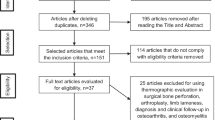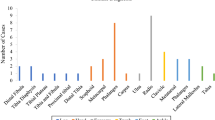Abstract
Musculoskeletal injuries are a leading cause of paediatric injuries and emergency department visits in Western countries. Diagnosis usually involves radiography, but this exposes children without fractures to unnecessary ionising radiation. We explored whether infrared thermography could provide a viable alternative in trauma cases. We compared radiography and thermal images of 133 children who had been diagnosed with a trauma injury in the emergency unit of a Spanish hospital. As well as the thermal variables in the literature, we introduced a new quantifier variable, the size of the lesion. Decision tree models were built to assess the technique’s accuracy in diagnosing whether a bone had been fractured or not. Infrared thermography had a sensitivity of 0.91, a specificity of 0.88 and a negative predictive value of 0.95. The new lesion size variable introduced appeared to be of main importance to the discriminatory power of the method.
Conclusion: The high negative predictive value of infrared thermography suggests that it is a promising method for ruling out fractures.



Similar content being viewed by others
Abbreviations
- ∆Tmax:
-
Differences of maximum temperatures
- ∆Tmean:
-
Differences of average temperatures
- ∆pix:
-
Differences of areas
- AUC:
-
Area under the curve
- CART:
-
Classification and regression trees
- DOR:
-
Diagnostic odds ratio
- CI:
-
Confidence interval
- NLR:
-
Negative likelihood ratio
- NPV:
-
Negative predictive value
- PLR:
-
Positive likelihood ratio
- PPV:
-
Positive predictive value
- ROI:
-
Region of interest
- SD:
-
Standard deviation
- Se:
-
Sensitivity
- Sp:
-
Specificity
References
Ammer K (2008) Standard procedures for recording and evaluation of thermal images of the human body: the Glamorgan protocol. Thermology Int 18:125–144
Ammer K, Ring FE (2007) Standard procedures for infrared imaging in medicine. In: Diakides NA, Bronzino JD (eds) Medical infrared imaging. Taylor & Francis, Boca Raton, pp pp 22.1–22.14. doi:10.5306/wjco.v2.i4.171
Arthur DT, Khan MM, Barclay LC (2011) Thermographic investigation of osseous stress pathology. Conf Proc IEEE Eng Med Biol Soc 2011:6250–6253. doi:10.1109/IEMBS.2011.6091543
Awerbuch MS (1991) Thermography—its current diagnostic status in musculoskeletal medicine. Med J Aust 154:441–444
Breiman L, Friedman JH, Olshen RA et al (1984) Classification and regression trees. Wadsworth, Monterey
Collard DC, Verhagen EA, van Mechelen W et al (2011) Economic burden of physical activity-related injuries in Dutch children aged. Br J Sports Med 45:1058–1063. doi:10.1136/bjsm.2010.082545
Di Benedetto M, Huston CW, Sharp MW et al (1996) Regional hypothermia in response to minor injury. Am J Phys Med Rehabil 75:270–277
Getson P, Schwartz RG, Hoekstra PP et al (2013) Guidelines for breast thermography [Internet]. American Academy of Thermology, Greenville
Hassan M, Chernomordik V, Vogel A et al (2007) Infrared imaging for functional monitoring of disease processes. In: Diakides NA, Bronzino JD (eds) Medical infrared imaging. Taylor & Francis, Boca Raton, pp pp 14.1–14.28
Head JF, Elliott RL (2002) Infrared imaging: making progress in fulfilling its medical promise. IEEE Eng Med Biol Mag 21:80–85. doi:10.1109/MEMB.2002.1175142
Howell KJ, Smith RE (2009) Guidelines for specifying and testing a thermal camera for medical applications. Thermology Int 19(1):5–14
Jover Gonzálbez A (2010) Protocolo de utilización de una cámara termográfica: Aplicación al estudio de la práctica deportiva [Protocol of use of a thermal imaging camera, Application to the study of sports practice] [master’s thesis]. Universidad de Valencia, Valencia (Spain)
Mettler FA, Bhargavan M, Faulkner K et al (2009) Radiologic and nuclear medicine studies in the United States and worldwide: frequency, radiation dose, and comparison with other radiation sources-1950-2007. Radiology 253:520–531. doi:10.1148/radiol.2532082010
Morillo López M (2012) Control de calidad de cámaras termográficas. Aplicación al diagnóstico no invasivo de patologías pediátricas [Quality control of thermal imaging cameras. Application to non-invasive diagnosis of pediatric diseases] [master’s thesis]. Valencia (Spain): Universidad de Valencia
Pascoe DD, Mercer JB, de Weerd L (2007) Physiology of thermal signals. In: Diakides NA, Bronzino JD (eds) Medical infrared imaging. Taylor & Francis, Boca Raton, pp pp. 6.1–6.20. doi:10.1201/9781420003864.ch21
Ring EFJ, Ammer K (2000) The technique of infrared imaging in medicine. Thermology Int 10:7–14. doi:10.1080/03091900600711332
Robin X, Turck N, Hainard A et al (2011) pROC: an open-source package for R and S + to analyze and compare ROC curves. BMC Bioinforma 12:77. doi:10.1186/1471-2105-12-77
Sanchis-Sánchez E, Vergara-Hernández C, Cibrián RM et al (2014) Infrared thermal imaging in the diagnosis of musculoskeletal injuries: a systematic review and meta-analysis. AJR Am J Roentgenol. Forthcoming
Saxena AK, Willital GH (2008) Infrared thermography: experience from a decade of pediatric imaging. Eur J Pediatr 167:757–764. doi:10.1007/s00431-007-0583-z
Schulze-Rath R, Hammer GP, Blettner M (2008) Are pre- or postnatal diagnostic X-rays a risk factor for childhood cancer? A systematic review. Radiat Environ Biophys 47:301–312. doi:10.1007/s00411-008-0171-2
Schwartz RG, O’Young B, Getson P et al (2012) Guidelines for neuromusculoskeletal infrared thermography sympathetic skin response (SSR) studies. American Academy of Thermology, Greenville
Silva CT, Naveed N, Bokhari S et al (2012) Early assessment of the efficacy of digital infrared thermal imaging in pediatric extremity trauma. Emerg Radiol 19:203–209. doi:10.1007/s10140-012-1027-2
Symonds ME, Henderson K, Elvidge L et al (2012) Thermal imaging to assess age-related changes of skin temperature within the supraclavicular region co-locating with brown adipose tissue in healthy children. J Pediatr 161:892–898. doi:10.1016/j.jpeds.2012.04.056
Vardasca R, Ring EFJ, Plassmann P, Jones CD (2012) Thermal symmetry of the upper and lower extremities in healthy subjects. Thermology Int 22(2):53–60
Author information
Authors and Affiliations
Corresponding author
Additional information
Communicated by Jaan Toelen
Electronic supplementary material
Below is the link to the electronic supplementary material.
ESM 1
(TIFF 3201 kb)
Rights and permissions
About this article
Cite this article
Sanchis-Sánchez, E., Salvador-Palmer, R., Codoñer-Franch, P. et al. Infrared thermography is useful for ruling out fractures in paediatric emergencies. Eur J Pediatr 174, 493–499 (2015). https://doi.org/10.1007/s00431-014-2425-0
Received:
Revised:
Accepted:
Published:
Issue Date:
DOI: https://doi.org/10.1007/s00431-014-2425-0




